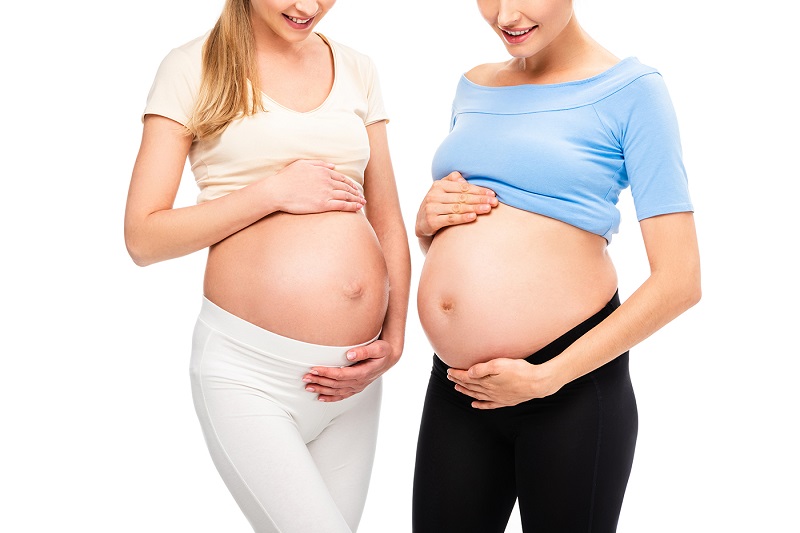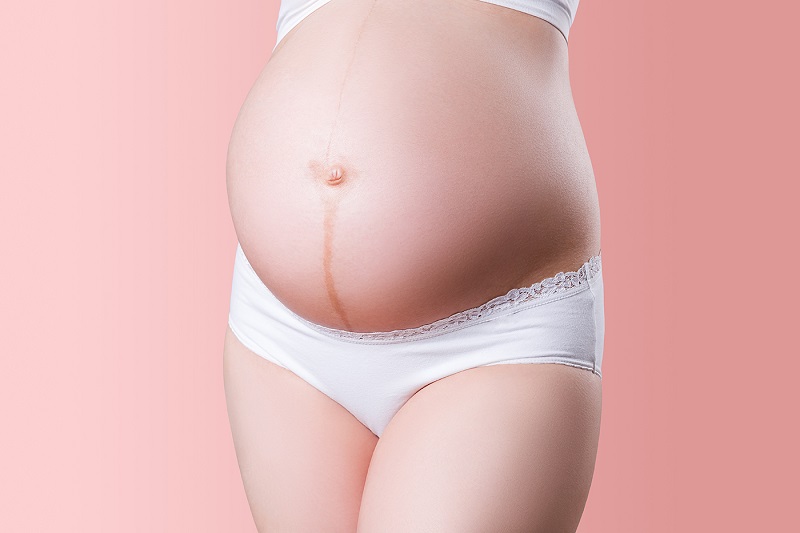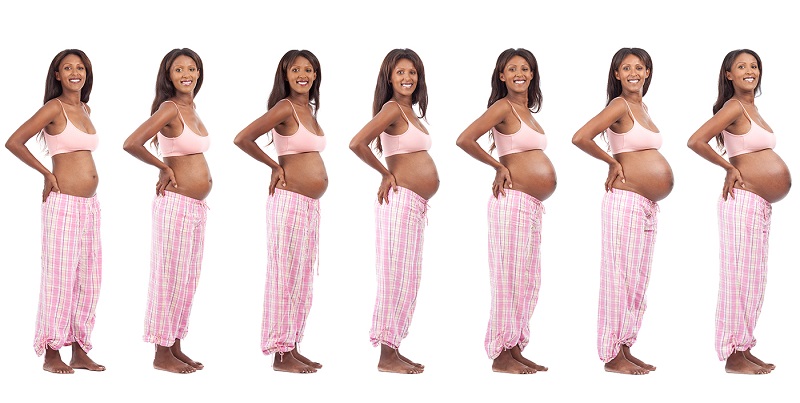Published on March 15th, 2020 and Updated on September 7th, 2025
Check out SneakPeek Gender Test to find out your baby’s gender as early as 6 weeks with over 99% accuracy!

One of the most exciting parts of being pregnant is watching your belly grow. But like many parts of pregnancy, it’s hard not to fixate on how your body’s changing.
If you’ve been wondering, “is my belly shape normal?”. Should I be bigger or smaller at this stage? What does my belly shape even mean? Pause, and take a breath.
The first thing to understand about pregnant bellies is that each one of them is unique. While there are medically acceptable size ranges and growth patterns, you might deviate from the norm—and that’s okay. Your individual belly is part of what makes your pregnancy special.
That said, knowing what to expect from your growing belly trimester-by-trimester can put your mind at ease and help you adjust to each new development as it comes. In this baby bump guide, we’ll walk you through everything there is to know about pregnancy belly shapes and sizes before (and after) your baby is born.
When will my baby bump start to show?
While there’s an average pattern to belly growth, every pregnancy has its unique milestones. Typically, pregnant bellies will become visible around 12 to 16 weeks —right before you’re due for a second-trimester checkup . Even so, some mothers begin to show a little sooner or later into their pregnancies depending on their unique physicality and how their pregnancy is progressing.
So, what factors will determine your pregnant belly’s size and shape? Seven physical traits play a significant role in shaping your belly throughout your pregnancy journey:
Your height
A mother’s height can impact how high her bump sits on her body. Taller women tend to “carry high,” meaning their bump rests closer to their chest, which gives the baby more room to grow vertically. Shorter women often “carry low,” meaning their bellies spread low and wide because there’s less room for vertical development.
Your weight
The higher your BMI or pregnancy weight gain, the larger your pregnant belly will appear in the end. That said, high body fat can actually obscure a bump earlier in pregnancy. In comparison, women with low body fat may show much earlier.
Your muscular structure
Your abdominal and pelvic muscles are responsible for supporting your uterus throughout your pregnancy. The tighter these muscles are, the longer it can take your belly to stretch and show. This is why athletic women often show later and carry their baby higher. Similarly, pregnant women who develop diastasis may show earlier. Diastasis is a common pre and post-partum condition where the abdominal muscles separate to make room for your growing baby.
Number of babies
If you’re carrying more than one baby, your belly will accommodate your bounty. Twin or triplet pregnancies will often show earlier than single-child pregnancies, adding an extra 10 to 15 pounds per baby to pregnancy weight.
Your age
As we age, the abdominal and pelvic muscles tend to weaken. This means pregnant individuals over 35 years old will typically begin to show earlier.
Your pregnancy history
If you’re on your second pregnancy, your muscles and ligaments will have an easier time reverting to the shape they assumed during your first pregnancy. This means that second or third (or greater) pregnancies typically show sooner than first pregnancies.
Your baby’s position
Babies can grow in almost any direction, leading to many different belly shapes—and sensations. For example, if the baby is in a posterior position (with his spine parallel to yours), your belly may feel tender to the touch, and you may feel kicks against your middle abdomen. In contrast, when a baby is in the anterior position (with his belly facing your spine), the belly button may protrude, and you may feel kicks near your diaphragm.
Types of pregnant belly shapes
Each pregnant belly is unique. That said, there are some ways childbirth professionals assess types of pregnancy belly shapes that can help serve as benchmarks for a healthy, happy pregnancy. Most baby bumps fall into four descriptive categories.
Small vs. large belly
Often, belly size comes down to optics. This is because the same-sized baby bump may look enormous on a short woman and inconspicuous on a tall woman. Measurable size differences generally result from multi-child pregnancies, though in rare cases, uncommonly large babies can create larger bellies.

Pointed vs. wide belly
Wide or “spread” bellies are common for tall women, who tend to have more space in their torso. In contrast, short women and women with diastasis see their bellies taper to a “point.” In turn, belly width can also indicate the position of your baby in utero. Wide bellies may signal a transverse lie (when your baby lies lengthwise in the uterus), while pointed or protruding bellies could mean your baby’s spine faces outwards.

High vs. low carry
Your physical build is the biggest factor when it comes to carrying high vs. low. Athletic or young women, women with longer torsos, and women with tight abdominal muscles often carry high in their bellies. In contrast, less active or older women, petite women, women with weaker muscles, and women who have been pregnant before tend to carry low in their bellies. Carrying low also means that the largest part of your abdomen is sitting low and closer to the pelvis. To get a better idea of what these positions look like, compare the carrying high vs. low pictures here.

D-shaped belly
A D-shaped belly is typically characterized by a round, smooth outline, resembling the shape of the letter “D.” This shape often suggests the baby is positioned with their back against the mother’s, making the belly appear more rounded.

B-shaped belly
When a pregnant belly develops a crease across the midsection, it’s known as a B-belly. This shape is usually created by weakened abdominal muscles or a high level of body fat. Most healthcare professionals will give extra attention to B-shaped bellies because they correlate with a higher risk for gestational disorders (e.g., miscarriage).

A timeline of pregnant belly stages
Pregnant baby bump types run a wide spectrum, but all follow a single trajectory over those nine months: continual growth.
In your first trimester, your fundal height (the area between your pubic bone and the top of your uterus) should steadily grow every week. By week 20, your fundal height will grow approximately 1 centimeter each week . Similarly, your weight gain should be 1 to 2 pounds per week from the second trimester until birth.
So, how will these changes look as you move through them? Below, you’ll find a timeline by pregnancy week of what to expect throughout each stage of your stomach’s evolution.

First trimester: Weeks 0 to 13
Technically, your first trimester begins on the first day of your last period (as opposed to the date you conceived). Over the next 13 weeks of early pregnancy, you might see and feel physical changes (and possibly a small baby bump) and early signs that hint at your growing baby. If you’re wondering how many weeks it takes you to find out the gender, you may be surprised to learn it’s possible earlier than you think. Some of these early signs include:
- Any fundal height growth up to 4 centimeters
- Maternal weight gain of 1 to 4 pounds
- Fluctuating belly size & shape (due to bowel distension and gas)
- In some women, a linea negra (the dark line that can form down the middle of your abdomen)
Even with no belly growth, know that your body is undergoing tremendous changes during your first trimester. (For instance, during this time, your uterus will reach the size of a grapefruit).
Because of these changes, your first trimester can bring uncomfortable symptoms of early pregnancy, like morning sickness, sore breasts, and fatigue. Make sure you monitor your pregnancy symptoms week by week and contact your healthcare provider if any symptoms interfere with your appetite or well-being.
Second trimester: Weeks 14 to 27
Often considered the “eye of the storm,” the calmer second trimester replaces bothersome first trimester symptoms , like nausea, with belly growth.
During this time, your body will develop traits like:
- Fundal height growth of up to 17 centimeters (about 1 centimeter per week)
- Weight gain of 14 to 28 pounds (1 to 2 pounds per week)
- Enlarged uterus size (approximately the size of a cantaloupe)
- Stretch marks across the stomach, legs, and other body areas
As your belly growth picks up speed & changes shape, your healthcare provider will begin to track your fundal height. This typically starts around week 20. From week 24 until your due date, your fundal height may mirror how far along you are in your pregnancy (i.e., at week 26, your fundal height should measure approximately 26 centimeters).
Third trimester: Weeks 28 to 40
For your belly growth and shape, your third trimester is the home stretch.
Throughout the third trimester, your belly will continue to grow (up until your due date), and you’re likely to undergo physical changes such as:
- Fundal height growth up to 26 centimeters or more (about 1 centimeter per week)
- Weight gain of 9 to 18 pounds (1 to 2 pounds per week)
- Enlarged uterus size (reaching the size of a pineapple)
- A “popped” belly button
Another important note: many pregnant women experience a belly drop , also known as “lightening,” in the third trimester, which can create a lower carry. Pregnancy dropping is completely normal, signaling that your baby is a few weeks away from delivery.
Common pregnant belly concerns
As your body changes throughout pregnancy and postpartum, it’s natural to have concerns about how your belly will look and feel. Let’s clear up some common concerns:
Weight fluctuations
Weight gain during pregnancy is both normal and crucial for a healthy pregnancy. Most women will gain between 20 to 40 pounds. Postpartum, it’s also normal to lose weight quickly, with up to 20 pounds shed within the first month due to the loss of blood and amniotic fluid. Breastfeeding can further accelerate this process.
Tracking your progress using a pregnancy weight gain calculator can help you monitor your weight and ensure you’re maintaining a healthy pregnancy.
Belly appearance
During pregnancy, you may notice physical changes such as stretch marks, scars, or a dark line down your abdomen (linea negra). Common changes include:
- Stretch marks and scars
- Linea negra (dark line on the abdomen)
- Discoloration
These changes are common and typically fade within 6 to 12 months after delivery.
C-section concerns
If you had a cesarean delivery, you might notice extra skin or flesh around the scar area. This is normal and with a few steps, you can heal properly. Gentle exercise combined with a balanced diet can help tone this area over time. Patience and self-care are essential as your body heals.
Post-pregnancy belly tips
After giving birth, your postpartum body will take time to return to its pre-pregnancy state. It’s common to still look about four or five months pregnant for several weeks postpartum. Keep the below in mind during postpartum:
- Set a realistic timeline: The uterus generally returns to pre-pregnancy size within 6 to 8 weeks.
- Ease back into exercise: Once cleared by your doctor, light exercises like walking and core workouts can help your body adjust. Look into tailored exercise programs for pregnancy and postpartum to find the safest workouts for each stage of your journey.
- Embrace the benefits of breastfeeding: Breastfeeding doesn’t just benefit your baby—it can offer benefits for your postpartum recovery as well. Breastfeeding can help with postpartum belly reduction, as it burns calories and promotes hormonal changes that aid in the shrinking of the uterus.
- Maintain a healthy diet: Eating nutritious foods, such as high-fiber cereals and vegetables, can help with digestion and weight loss after pregnancy.
Can belly shape predict a baby’s gender?
You’ve probably heard a few pregnancy myths about a baby’s sex affecting belly shape or size. However, according WHO growth charts published by the CDC:
- Females in the 50th percentile weigh 7 lb 2oz and are roughly 49.1cm in length
- Males in the 50th percentile weigh 7 lb 6oz and are roughly 49.9cm in length
With boy and girl babies may differ by 4 ounces and 0.8 cm, baby’s gender doesn’t account for the visibly different tummy sizes of pregnant women. So, it’s safe to say you cannot guess your baby’s gender based on your belly size.
Pregnancy belly FAQs
Why am I not showing yet?
Body type, muscle tone, and whether it’s your first pregnancy can affect when your bump becomes noticeable. If you’re slender, you might show earlier, while those with more curves may not show until later.
When does your belly button pop out when pregnant?
Your belly button might pop out during pregnancy due to the growing pressure of your expanding uterus. This typically happens between 24 and 28 weeks, though it can vary for each person.
Why does my pregnant belly look smaller some days?
It’s common for a pregnant belly to fluctuate in size due to factors like gas, bloating, or the position of the baby. Your belly may appear smaller in the morning after a night of rest and appear larger later in the day due to digestion.
Is a pregnant belly hard or soft?
A pregnant belly can feel both hard and soft at different times. Early in pregnancy, it may feel soft as the uterus is still growing. As the pregnancy progresses, the belly can become firmer, especially when the baby is active.
Grow together with SneakPeek
Every week your pregnant belly grows and changes shape, and so will your excitement. As the inches add up and you watch your baby’s development, it’s easy to begin wondering, who will my baby become? And will they be a boy or a girl?
Luckily, SneakPeek’s At-Home Early Gender Test can give you the answers your belly shape can’t provide.
At just 6 weeks into your pregnancy, our test can predict your baby’s gender with over 99% clinically-proven accuracy—that’s before your 18-week gender reveal ultrasound and even before your baby bump surfaces.
Accurate, easy-to-use, and recommended as the #1 at-home gender test by OBGYNs, our data-protected test kits are used by over 1 million parents. To get the science-backed answers to who your belly bump is hiding, order your SneakPeek Test® today!
Editorial Policy
At SneakPeek, our commitment is to provide accurate, up-to-date, and reliable information to empower our readers. Our content is thoroughly researched, reviewed by medical experts, and fact-checked to ensure its credibility. We prioritize the well-being and education of our readers, and our editorial policy adheres to the highest standards of integrity and accuracy in all our articles.
This post has been reviewed for accuracy by the following medical professional:
Katie Smith is a seasoned Certified Nurse Midwife and a nurturing mother to six children, offering a unique blend of professional expertise and personal experience. She is the founder of Birth Your Way Midwifery and Women’s Wellness Center in Bay County, Florida. Katie's comprehensive approach to care is informed by her hands-on experience in motherhood and her passion for empowering women through their birthing journey. Her dedication extends beyond her center as she actively engages in community wellness and family health education.
Sources:
- American Pregnancy Association. Weight Gain with Twins
https://americanpregnancy.org/healthy-pregnancy/multiples/weight-gain-with-multiples/ - CDC. Growth Charts – Data Table for Boys Length-for-age and Weight-for-age Charts
https://www.cdc.gov/growthcharts/who/boys_length_weight.htm - CDC. Growth Charts – Data Table for Girls Length-for-age and Weight-for-age Charts https://www.cdc.gov/growthcharts/who/girls_length_weight.htm
- Cleveland Clinic. Advanced Maternal Age (Geriatric Pregnancy): Definition & Risks
https://my.clevelandclinic.org/health/diseases/22438-advanced-maternal-age - Medical News Today. What the different baby positions in the womb mean during pregnancy
https://www.medicalnewstoday.com/articles/323099 - Cleveland Clinic. Diastasis Recti (Abdominal Separation): Symptoms & Treatment
https://my.clevelandclinic.org/health/diseases/22346-diastasis-recti - Cleveland Clinic. Why Do Belly Buttons Pop During Pregnancy?
https://health.clevelandclinic.org/why-do-some-womens-belly-buttons-pop-out-during-pregnancy/ - Global News. Baby bumps aren’t the same size — here’s why
https://globalnews.ca/news/5236861/baby-bump-sizes/ - Healthline. Baby Dropping: When Does It Happen?
https://www.healthline.com/health/pregnancy/baby-dropping - Healthline. Pregnant Belly: Does Size Matter?
https://www.healthline.com/health/pregnancy/pregnant-belly-size#Measurements- - Healthline. What Is a B Belly During Pregnancy and Why Does It Happen?
https://www.healthline.com/health/pregnancy/b-belly-pregnancy - Insider. When Do You Start Showing in Pregnancy?
https://www.insider.com/guides/health/reproductive-health/when-do-you-start-showing-in-pregnancy - Kids Health. Prenatal Tests: Second Trimester
https://kidshealth.org/en/parents/tests-second-trimester.html - Mayo Clinic. Fundal height
https://www.mayoclinic.org/healthy-lifestyle/pregnancy-week-by-week/multimedia/fundal-height/img-20008049 - Verywell Family. 5 Concerns About Your Pregnant Belly
https://www.verywellfamily.com/concerns-about-your-pregnant-belly-2759765 - What to Expect. Your Pregnant Belly Size and Shape
https://www.whattoexpect.com/pregnancy/ask-heidi/week-31/size-and-shape.aspx - Healthline. Saying Adieu to Your Postpartum Belly (but Celebrating It, Too)
https://www.healthline.com/health/womens-health/postpartum-belly#timeline - Baby Center. Everything you need to know about your post-pregnancy belly
https://www.babycenter.com/baby/postpartum-health/post-baby-belly-how-long-you-might-look-pregnant_1152349 - Pregnancy and Postpartum TV Youtube. Postpartum Recovery (Stretches and Postpartum Kegel Exercises For The First 6 Weeks Postpartum)
https://www.youtube.com/watch?v=ue4wcRcRGik - Verywell Health. Pregnant Belly in First, Second, and Third Trimesters. https://www.verywellhealth.com/pregnant-belly-5116657
- Healthline. When Does Your Baby Bump Start to Show? https://www.healthline.com/health/pregnancy/when-do-you-start-to-show








